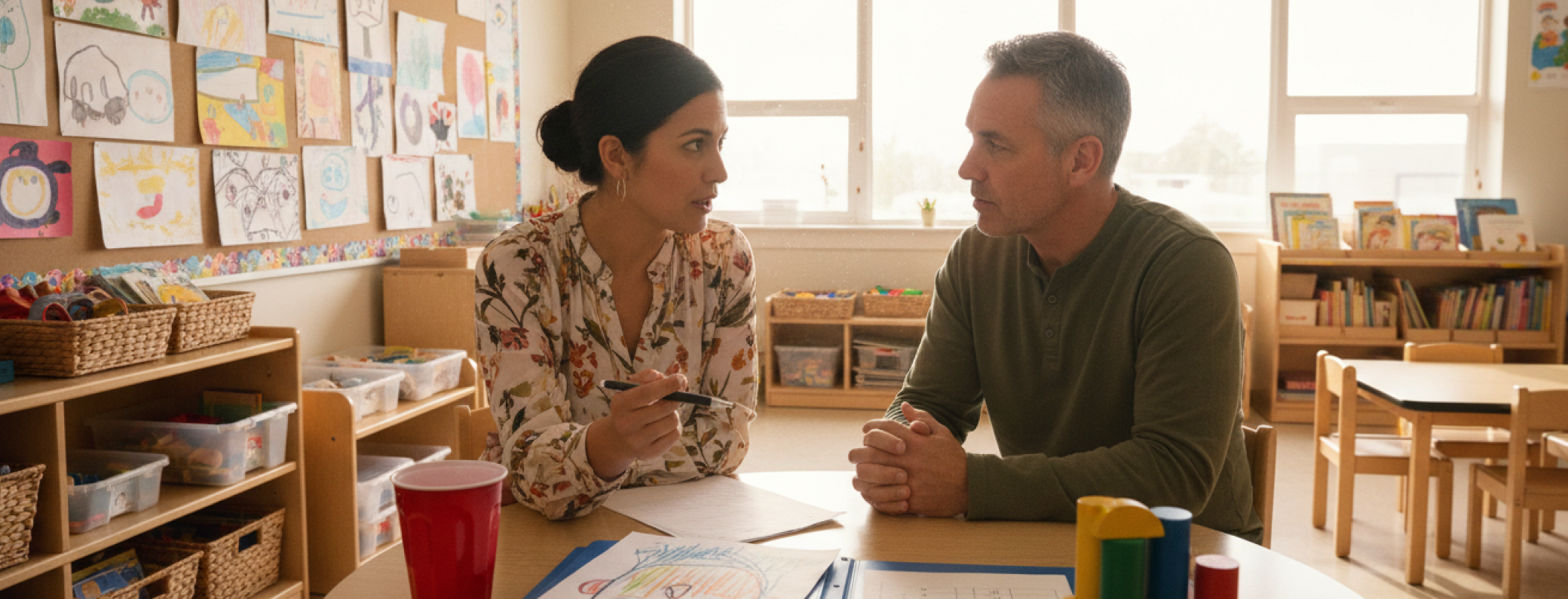Imagine a child picking up a pencil for the first time. They shift it between their fingers, press a little too hard, or draw lines that wobble across the page. You kneel beside them, gently adjust their grip, and say, “Try it like this.” Little by little, their movements become more deliberate, more confident.
That moment, that quiet, responsive support, is what scaffolding looks like in early childhood education. It’s offering just enough help to keep learning within reach, while still letting children take the lead. It’s the invisible hand that helps them rise, one small success at a time.
What Is Scaffolding in Early Learning?
In early childhood, learning happens through play, exploration, and relationships. Scaffolding is a teaching approach that meets children right where they are, and gently nudges them forward.
At its core, scaffolding means giving temporary support to help a child complete a task they couldn’t do on their own. As the child builds skill and confidence, the support gradually fades, much like the scaffolding around a building or bridge during construction.
It’s a dynamic, flexible process that requires us to observe closely, respond thoughtfully, and adjust continually in order to meet the child where they are and with what they need.
A Quick History: Where the Term Comes From
The concept of scaffolding was introduced by educational theorists Jerome Bruner, David Wood, and Gail Ross in the 1970s. It’s rooted in Lev Vygotsky’s earlier idea of the Zone of Proximal Development (ZPD), which refers to the gap between what a child can do independently and what they can do with assistance.
Scaffolding happens in that space, in the ZPD, where learning is most alive.
Why Scaffolding Matters in the Early Years
Young children are constantly on the edge of new skills: taking turns, stringing words into sentences, pouring water without spilling. Scaffolding meets them in those moments of potential and helps them succeed without taking over.
Here’s what effective scaffolding offers:
-
A sense of capability: Children feel empowered when they accomplish tasks with a little help, not frustrated by too much struggle or made passive by too much direction.
-
Deeper understanding: Instead of memorizing or mimicking, children develop real thinking skills and learn how to learn.
-
Emotional safety: Gentle guidance builds trust. Children are more likely to take risks and explore when they feel supported.
-
Individualized learning: Scaffolding isn’t one-size-fits-all. It adapts to each child’s pace, strengths, and needs, making it ideal for inclusive settings.
Key Principles of Scaffolding in Early Education
While scaffolding looks different depending on the child and the situation, some core principles apply across the board:
1. Connection Comes First
Children need to feel safe and connected before they can learn. Responsive relationships are the foundation for any kind of support.
When children know you’re in their corner, they’re more likely to stretch into new territory.
2. Observe Before Acting
Effective scaffolding begins with careful observation. Before jumping in, ask:
-
What is the child trying to do?
-
What parts are they managing independently?
-
Where are they getting stuck?
This helps you avoid over-helping or under-challenging.
3. Offer the Right Kind of Support
Scaffolding isn’t about doing it for the child. It’s about doing it with them, just enough to keep them engaged and successful.
Support can look like:
-
Asking open-ended questions
-
Modeling a skill
-
Breaking a task into smaller steps
-
Providing tools (like visuals or prompts)
-
Encouraging problem-solving
4. Use Language to Lift Thinking
Conversation is one of the most powerful scaffolding tools. Through rich dialogue, children make connections, reflect, and refine their ideas.
Try:
-
Recasting what a child says (“You’re building a tower. Tell me about your design.”)
-
Introducing new vocabulary
-
Asking “what if” and “why” questions
-
Narrating the process (“I see you’re trying different ways to make it balance.”)
5. Know When to Step Back
As a child gains confidence, the adult gradually fades their support, allowing the child to take full ownership of the task. This “release of responsibility” is a hallmark of effective scaffolding.
Resist the urge to fix or finish. Let the child lead, and celebrate their growing independence.
Scaffolding Across Developmental Domains
Scaffolding isn’t just for academic skills. It supports all areas of development:
Cognitive & Problem-Solving
-
Providing sorting trays during a math activity
-
Offering hints during a puzzle instead of placing pieces
-
Asking “What could you try next?” when a plan isn’t working
Language & Communication
-
Expanding on a child’s sentence (“Dog run.” → “Yes, the dog is running fast!”)
-
Using visual schedules to support routine communication
-
Giving a child time to find words before jumping in
Social & Emotional Skills
-
Role-playing how to ask for a turn
-
Modeling conflict resolution with puppets
-
Naming emotions and helping children find solutions
Physical & Motor Skills
-
Offering a hand when climbing up a new structure, but not carrying
-
Breaking a complex movement (like cutting) into parts
-
Using adaptive tools when needed (like thicker crayons or scoop spoons)
Real-World Examples of Scaffolding in Action
Let’s see what scaffolding looks like in everyday early childhood environments:
In the Classroom: Snack Time
-
Before: A child spills milk while pouring.
-
Scaffold: The educator places a small pitcher, models pouring slowly, and says, “Hold it with both hands like this.”
-
Outcome: Over time, the child pours independently with pride.
During Art Exploration
-
Before: A child wants to cut out shapes but struggles with scissors.
-
Scaffold: The educator draws large shapes to trace and offers loop scissors.
-
Outcome: The child develops control and begins cutting more complex forms.
Story Time
-
Before: A child listens passively during read-alouds.
-
Scaffold: The educator pauses to ask, “What do you think will happen next?” or invites the child to turn the page.
-
Outcome: The child becomes more engaged and begins retelling stories later.
Scaffolding and Inclusion
Scaffolding is at the heart of inclusive practice. Because it is responsive and flexible, it allows each child to participate meaningfully, regardless of ability, language background, or learning style.
Ways scaffolding supports inclusion:
-
Using visual aids for children with language delays
-
Repeating instructions and modeling for multilingual learners
-
Allowing extra processing time or offering movement breaks
-
Using sign language or gestures alongside speech
The goal is access, not sameness and scaffolding ensures every child has a way in.
The Role of the Educator: Guide on the Side
In a scaffolded classroom, the educator isn’t the center of attention, instead, they’re beside the child, observing, responding, and gently guiding.
This approach requires:
-
Patience: Allowing time for the child’s process to unfold
-
Flexibility: Adjusting support on the fly
-
Reflection: Asking “What worked? What can I try differently next time?”
The more in tune we are with each child’s learning path, the more precise our support becomes.
Tips for Families: Scaffolding at Home
Parents and caregivers scaffold all the time, often without realizing it! From teaching how to tie shoes to helping solve sibling conflicts, home is full of opportunities to guide learning with warmth and care.
Here’s how families can scaffold at home:
-
Break tasks into steps: “First we get socks, then we find shoes.”
-
Use visual supports: Picture charts for routines, feelings, or chores
-
Model thinking out loud: “Hmm… where could that missing sock be?”
-
Let children lead: Give choices and ask for their ideas
-
Celebrate effort: “You didn’t give up, even when it was tricky!”
These simple practices nurture problem-solving, independence, and confidence.
Avoiding Common Pitfalls
Scaffolding is powerful, but like any tool, it can be misused. Here’s what to watch for:
-
Over-scaffolding: Doing too much or offering help too soon can prevent learning. Children need space to try and sometimes fail.
-
Inconsistent support: If scaffolding changes too often, it can confuse rather than help.
-
One-size-fits-all: What works for one child may not work for another. Scaffolding must be tailored.
The best scaffolding is subtle, fluid, and responsive, offering just the right nudge at the right time.
Final Thoughts: Helping Children Rise
Scaffolding is more than a strategy, it’s a mindset. It asks us to slow down, stay present, and really see each child. It invites us to believe in their potential and support their journey with gentle guidance and trust. When we scaffold well, we create more than capable learners, we build resilient, curious, and confident humans. So the next time a child is on the edge of something new, pause. Watch. Listen. Then offer a hand, not to carry them, but to steady them as they rise because learning doesn’t happen all at once.
Interested in Joining the Parent Community?
Parent is a simple, powerful tool that helps early education centers stay connected, organized, and focused on what matters most: the children. From daily communication and attendance to billing and staff management, everything you need is in one place. Parent makes it easy for teams to work together and for families to feel involved and supported. Trusted by centers across the globe, Parent is built to empower educators.
Let’s talk — book a quick, no obligation, walkthrough with our team
If you found this post helpful, explore our free webinars, activity library, and newsletter for more support in your early years journey.
Billing, Invoicing Automation & Smart Finances
Communication & Engagement
Child Development & Progress
Waitlist, Forms & Attendance
Effortless Team Management
Daily Updates That Matter
Templates & Printables
Blogs
Webinars
Case Studies & Testimonials
FAQs
Help Center


.png)

